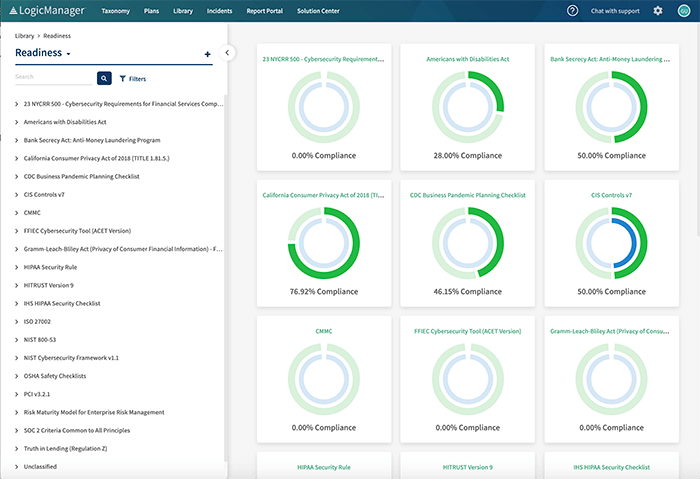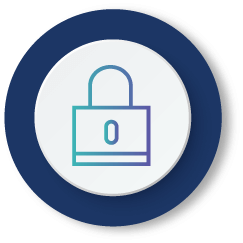NIST Cybersecurity Readiness Assessment
Achieving NIST compliance is essential for companies looking to prioritize cybersecurity. Meet the heightened obligations of this critical IT compliance standard with LogicManager's risk-based NIST Cybersecurity Readiness Assessment solution.
For additional value:
Why a Risk-Based Approach to the NIST Cybersecurity Readiness is Important:
How LogicManager’s NIST CSF Solution Helps
- Our Readiness Assessment breaks down the NIST CSF framework into individual responsibilities, distributes tasks to activity owners, and links them to your existing controls to be documented as evidence along the way.
- Deploy automated testing to provide evidence that your IT governance program is aligned to the framework over time.
- LogicManager’s One-Click Compliance AI searches through your existing library of IT controls, policies and procedures and suggests which ones to leverage for demonstrating alignment with NIST CSF, reducing internal labor costs of compliance.
- Personalize LogicManager home screens to help simplify the complex process of NIST CSF implementation by bringing your IT team directly to the information they need, such as a readiness dashboard or their list of open tasks.
- LogicManager’s Event Management functionality allows you to create and operationalize a process for tracking and remediating anomalies and events so that you can uncover the root cause and prevent repeat occurrences.
- Use our Reporting & Dashboard tools to visualize control deficiencies, historical results of Framework alignment, readiness summaries, testing calendars, and more to continually improve your program.
- LogicManager’s Integration Hub allows you to connect with platforms like Jira to pull in an existing library of cybersecurity risks and controls or Office365 to show how relevant controls in your audit reports demonstrate NIST CSF compliance.

COMPLIMENTARY DOWNLOAD:
NIST Cybersecurity Annotated Guide
NIST Cybersecurity Annotated Guide
Discover key categories of the NIST Cybersecurity Framework as well as how a risk-based approach can operationalize this standard.
Benefits of Achieving NIST CSF Compliance
Mitigate cybersecurity threats
With LogicManager as your mission-critical NIST CSF partner, you’ll be able to mitigate cybersecurity threats by following established industry standards and best practices. The process for managing cybersecurity should follow a prioritized, flexible, repeatable, performance-based, and cost-effective approach.
Maintain a documented list of controls
For organizations starting from the ground up with cybersecurity, using an industry-standard like the NIST CSF is the perfect way to document mitigations that already exist while also triggering remediation for those that do not. Your organization may already have controls that align with NIST requirements, they just aren’t documented yet. By conducting an assessment for NIST CSF compliance, you can link your organization’s existing controls to the NIST requirements that they satisfy, create new controls that simply were not documented, and call attention to gaps in alignment. You can also identify specific mitigations that align with prescribed controls from NIST.

Create and manage your control repository with purpose
When examiners look at your documented controls, they want to know the “why” behind each one. The best way to demonstrate your methodology is by demonstrating your controls’ connections to your strategic goals. By conducting a NIST Cybersecurity gap assessment, the controls you document will have a direct relationship to prescribed industry best practices.
Align with other industry standards
NIST has various standards that your NIST CSF should map to so you’ll be well on your way to comply with their other IT Security standards and frameworks, such as:
- CIS Critical Security Controls v7.1
- COBIT 5
- ISA
- ISO 27001
- NIST 800-53
- NIST 800-171
What is the NIST Cybersecurity Framework?
The National Institute of Standards and Technology (NIST) is a physical sciences laboratory and a non-regulatory agency of the United States Department of Commerce. Their mission is to foster industrial competitiveness and spark innovation. NIST carries out this mission through various frameworks. One of the most notable NIST frameworks is the NIST Framework for Improving Critical Infrastructure Cybersecurity, commonly referred to as the NIST Cybersecurity Framework (CSF). NIST CSF provides private organizations with a best-practice structure for preventing, detecting, and responding to cybersecurity risks. The security controls aligned with NIST CSF are tested as part of an organization’s periodic SOC 2 Type 2 Report Audits, which typically cover a 12-month period.
There are 3 parts of the Framework, which are as follows:
- The Framework Core, which consists of a set of cybersecurity activities, desired outcomes, and applicable references that are common across critical infrastructure sectors consisting of 5 functions: Identify, Protect, Detect, Respond and Recover.
- Implementation Tiers that describe the degree to which an organization’s cybersecurity risk management practices exhibit the characteristics defined in the Framework.
- A Framework Profile that represents a business’ core functions and needs and can be used to measure progress towards objectives.
So why should you consider aligning your security efforts with NIST CSF? Consider the fact that customers today expect their sensitive information to be protected from theft, disclosure, or misuse at all costs. Protecting that information shows customers that you value their business. Implementing a credible cybersecurity program can be a key differentiator for your company by helping you gain and retain not only customers but employees and other stakeholders. Complying with NIST CSF makes it easier to comply with other security frameworks, such as PCI DSS or IT SOX. This means achieving NIST CSF compliance means you’re saving time and resources down the road.
NIST Cybersecurity Risks
- It’s one thing to become NIST CSF compliant. However, maintaining that status year over year is critical – and often challenging. Technology and best practice standards today change frequently, meaning your mitigations weaken over time. If your organization is unable to report on the results of your mitigation efforts consistently over time, you won’t be able to flag issues as needed and risks will have a higher likelihood of materializing.
- Cybersecurity threats directly impact your company’s bottom line. Not only can these threats drive up costs and impact revenue, but working to manage them hinders your organization’s ability to innovate and focus on strategic initiatives. Warding off threats can require hours of tactical, manual labor every day.
- Cybersecurity-related incidents are one of the most common root causes of corporate scandals. Corporate scandals have proven negative effects on reputation, which can ultimately lead to difficulty gaining and maintaining customers. They also are shown to negatively impact employee morale, leading to decreased productivity, higher turnover rates, and interrupted business processes.
Request a DemoLearn How LogicManager’s NIST Cybersecurity Readiness Assessment Can Transform Your ITRM Program
Speak with one of our risk specialists today and discover how you can empower your organization to uphold their reputation, anticipate what’s ahead, and improve business performance through strong governance.






